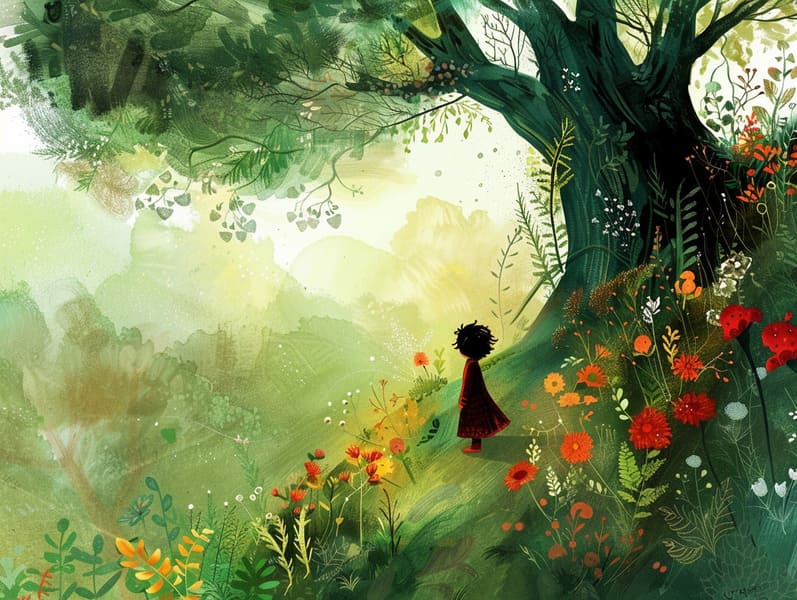
Historical fairy tales have ancient roots. These tales have been passed down from one generation to the next far before they were ever inscribed. They were born from a variety of societies, including Eastern traditions. They were initially narrated among older generations, often carrying themes and messages relevant to the societal norms and beliefs of the time.
The Brothers Grimm, Jacob and Wilhelm, were among the first to gather many of these beloved stories. Their anthology, "Grimm's Children's Stories," included tales like "The Story of Cinderella," "Little Brother and Little Sister," and "The True Story of Snow White," which have since become cornerstones in the world of iconic fairy tales. Similarly, Hans Christian Andersen's fantastical narratives, such as "The Story of the Little Mermaid," and "The Duckling that Could," have captured hearts worldwide, establishing their place in the pantheon of treasured fairy tales.
Despite their age, classic fairy tales remain as meaningful as ever, especially as nighttime stories for kids. These whimsical stories are now available in multiple formats, including colorful picture books, captivating animations, and digital storybooks.
Their continued relevance can be ascribed to several delightful features:
Important Morals: Traditional fairy tales often teach important moral lessons. Narratives like "The Wolf and the Liar" teach the importance of sincerity, while "The Tortoise and the Hare" demonstrate the virtues of persistence and unpretentiousness. These stories offer young readers clear distinctions between virtue and vice, forming their moral compass in a kind yet profound way.
Compassion and Knowledge: Classic fairy tales frequently include protagonists facing obstacles and hardships, urging listeners to identify with their struggles and support their triumphs. For instance, "Beauty and Her Beast" teaches us the virtue of appreciating inner worth to appreciate the inner being of a being, promoting warmth and insight.
Cultural Understanding: Many traditional fairy tales are imbued with the cultural contexts from which they originated. Exploring these tales can provide informative snapshots into different heritages, fostering a sense of cultural understanding and awareness.
Imagination and Innovation: The imaginative elements in fairy tales—fairy godmothers—enhance children’s creative minds. These narratives move readers to extraordinary realms, fostering innovative thinking and a sense of delight that endures a lifetime.
Timeless fairy tales are not only entrancing but also educational. They work as fantastical tools in cultivating various thinking and feeling skills in the young. When old fairy tales are spoken out loud, they enhance language acquisition by bringing new word meanings and complex sentence structures. This practice also cultivates listening skills and focus, as children focus on every detail, expectant to see what happens next.
Furthermore, deliberating the themes and characters of traditional fairy tales can foster reasoning skills and analytical skills. Young ones are led to discover patterns, predict happenings, and realize cause and effect. These conversations also assist kids say their thoughts and feelings, promoting their emotional intelligence.
In today’s technological age, the accessibility of internet fairy tales has made these fairy tales more attainable than ever. Web-based platforms and programs make available wide arrays of popular fairy tales that can be seen or listened on anytime, anywhere. Fairy tales recited are particularly in demand, sharing an entertaining method for the young to immerse in these delightful tales. Read-aloud stories and read-aloud videos carry characters and settings to life, often augmented by whimsical sound effects and background music that enrich the tale-telling adventure.
The timeless fascination of old fairy tales lies in their ability to evolve to current times while keeping hold of their core messages. Contemporary adaptations of these fairy tales often integrate more varied characters and modern settings, making them relevant to today’s audience. However, the key lessons of fearlessness, compassion, and fair-mindedness remain unchanged, continuing to connect with young listeners of all ages.
Timeless fairy tales also offer a sense of comfort and familiarity. They allow a organized narrative with a recognizable beginning, here middle, and end, often concluding with the ending of conflicts and the triumph of virtue over vice. This constancy can be encouraging for kids, making known a sense of solidity in an unpredictable world.
Timeless fairy tales continue to charm and enlighten new generations, maintaining their splendor and importance in modern society. As kids' bedtime tales, they showcase a perfect blend of charm and enlightenment, furthering moral values, empathy, and creativity. The presence of internet fairy tales and the prevalence of fairy tales read out loud secure that these classic fairy tales remain accessible to new generations.
By perpetuating and narrating these stories, we continue to honor the rich tapestry of lore and cultural heritage. Whether you are browsing a richly illustrated book, seeing a virtual collection, or hearing an narrated book, the wonder of timeless fairy tales is always within reach. These narratives highlight of the perpetual force of tales and its ability to hold us together across generations and cultures.
Regardless if you are exploring a gorgeously illustrated book, enjoying a digital collection, or listening on an audiobook, the captivation of ancient fairy tales is always within reach.
These narratives demonstrate of the unchanging presence of fairy tales and its ability to join us across time and space, casting a charm that charms and informs alike.
Comments on “A Brief History of Best Fairy Tales with Its Continued Elegance.”